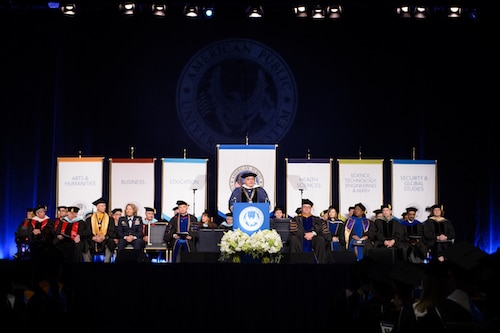By Haley Hawthorne
Manager, University Events
Each year in May and June, graduates across the country put on the traditional cap and gown and walk across a stage to shake a school leader’s hand and receive a diploma. Commencement ceremonies happen at almost every educational institution from the neighborhood preschool to the most elite, ivy-covered universities.
So why do we have graduation ceremonies like Commencement? Why is this singular event so important that four-year-olds and 74-year-olds alike take part in this academic tradition?
Commencement Marks a Transition and a Beginning
Commencement serves as a marker of transition. Much like your 18th birthday marks your entry into adulthood, commencement ceremonies mark a major life milestone.
The word “commence” means “to begin.” So while the Commencement ceremony is held at the end of your formal education, it marks the beginning of life’s next great adventure. For preschoolers, it means starting elementary school. For seniors in high school, it marks the beginning of college or other adventures, often undertaken alone without parental guidance for the first time.
For our AMU and APU graduates, Commencement marks both an end and a beginning. It’s the end of an academic journey marked by struggles and challenges; our students often balance a career, a family, and classes. For these graduates, Commencement is the culmination of hard work, dedication, and perseverance; it also bears witness to the beginning of a bright future filled with opportunity and hope.
Graduating this year? Be sure to use #APU4Life or #AMU4Life on your Facebook, Instagram, Twitter and LinkedIn posts! |
Commencement isn’t complete without all the pageantry we’ve come to expect. The pomp and circumstance of Commencement is a display of the long-held traditions of higher education. And while our institution only dates back 31 years, many of the graduation traditions we observe date back for centuries.
Related link: Congratulations to Our 2022 Student and Alumni Award Winners!
The Symbolism behind Commencement Regalia
Officially known as a mortarboard, the graduation cap is probably the single most recognizable symbol of graduation in the world and has been in existence since medieval times. Traditionally worn by graduates at all degree levels (although many doctorate-level graduates now wear a soft, six-sided cap called a tam), the mortarboard should be worn flat on the head with its flat top parallel to the ground.
Each university handles the turning of the mortarboard’s tassel – an act marking the final transition from students to alumni – a little differently. For us, our graduates will move their tassels from right to left at the direction of our provost Dr. Vernon Smith, once all degrees have been awarded.
The gowns and other items worn by our faculty and students carry symbols of their educational journey and provide details about the wearer’s education. For instance, both master’s- and doctorate-level graduates wear hoods that symbolize the degree they earned and the university that awarded the degree.
Some accessories worn by our graduates indicate their status as an honors graduate, their affiliation with specific groups or their desire to add something special to a very important day. Some universities are very strict about what accessories they allow. But at our University, we want our grads to celebrate their academic journey their own way and encourage them to wear accessories that reflect their personalities and academic journeys.
The University Mace
Remember all those centuries-old traditions mentioned earlier? They’re everywhere in our Commencement ceremony.
The procession of graduates is led by a designated macebearer who carries the University mace, which is the most sacred symbol of office. The University mace signifies the authority of our University president.

Our macebearer needs to have some serious muscle because our mace is heavy. It is so heavy, in fact, that the stand it rests in during the Commencement ceremonies had to have weights added to the base a few years ago so it would be able to hold the mace in an upright position.
The School Banners of Commencement
Each of the University’s colleges are represented by a gonfalon (a vertical banner suspended on a pole), and these banners are proudly displayed during the Commencement ceremony. Near these banners, important university officials such as school deans and Board members sit on the stage as a nod to their leadership and authority. Faculty members, dressed in their regalia, also sit near the graduates in a show of support.

Presenting Ceremonial Diplomas at Commencement
One of the most important parts of any commencement ceremony is the presentation of degrees. We don’t think our graduates should have to wait for Commencement to get the benefits of holding that degree. We have six conferrals each year, and our graduates receive their official diplomas following their official graduation.
As a result, we don’t hand out official diplomas at Commencement. Instead, each graduate receives a ceremonial diploma as he or she crosses the stage.
The stage crossing is the single, most revered part of Commencement for our graduates. That short walk may not take many steps, but it signifies the end of a long journey for many people. We know it’s important to have that moment, so we have invited the graduates of 2020 and 2021, whose Commencement ceremonies were virtual, to join the 2022 graduates this year to take that all-important walk.
2022 – Our Biggest Commencement Ever!
Commencement takes year-round planning. Our team has been planning this Commencement since July 2021, and we’ll start planning 2023 right after the July 4th holiday. It takes around 200 volunteers to make the Commencement weekend happen.
This year, we have invited over 40,000 graduates to join us for our biggest Commencement weekend in school history. While we understand that many of our graduates will be unable to join us for a multitude of reasons, they will be in our hearts and on our minds as we celebrate together on June 18, 2022.
Congratulations to all of our graduates! You did it!

Comments are closed.